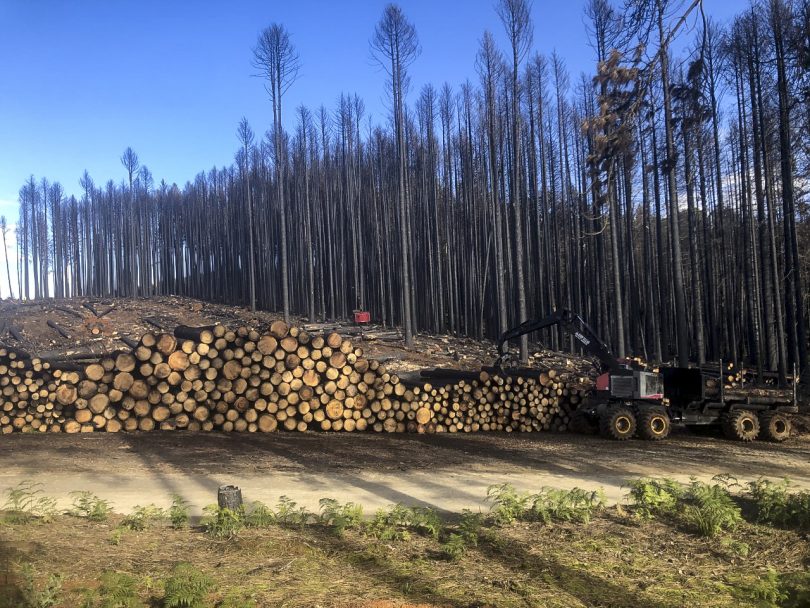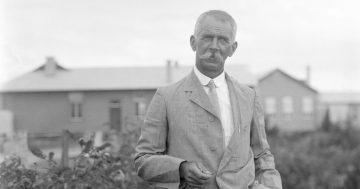
The iconic Sugar Pine Walk is currently being cleared after devastating bushfires ripped through Bago State Forest in early 2020. Photo: Forestry Corporation of NSW.
In one of the most mournful chapters of the enduring story that is the aftermath of the 2019-2020 bushfires for the Batlow and Tumbarumba region, the majestic trees that lined Sugar Pine Walk in Bago State Forest are now piles of logs.
In recent weeks, Forestry Corporation of NSW has been working to dismember the forest – covering approximately 100 hectares of land – which was so badly burnt in the Dunns Road bushfire, it rendered the iconic tourist attraction dangerous to visitors.
Sugar pine (Pinus lambertiana) is the tallest pine species on earth and Sugar Pine Walk – a small, gently upward sloping 500m section of protected forest – was planted in 1928 when a range of different exotic species were being trialled by the forestry industry.

The 2019-2020 bushfires destroyed the entire Sugar Pine Walk plantation, which was planted in 1928. Photo: Forestry Corporation of NSW.
But as the local softwood timber industry focused attention on radiata pine, sugar pines continued to thrive and, in time, became one of the region’s most photographed tourist attractions.
Close planting and the way the trees have grown over time created a unique cathedral-like experience for visitors walking under the Sugar Pine Walk canopy.
It enchanted people to silence, bore witness to many a wedding and echoed the squeals of generations of delighted children with awoken imaginations, evidenced by small cubbies and racing feet darting behind the trunks of the 75m giants.
The process of removing burnt timber to make the area safe began several weeks ago and involves a team of eight people, including harvesting and haulage contractors and Forestry Corporation of NSW staff who have been using specialised mechanical harvesting machines, a forwarder and log trucks.
Forestry Corporation of NSW says that while all trees have been badly burnt and will die, it is likely some timber beneath the burnt bark will still be useable.
Some of that timber will be set aside to incorporate into a planned new visitor centre in the area, and the rest will likely be sold if an appropriate application for the sugar pine timber can be found.
“This process is at early stages and will need planning to accommodate this particular species,” said Rod Campbell of Forestry Corporation of NSW. “Sugar pine is a species of timber we do not normally grow in NSW.”

The remains of Sugar Pine Walk last week. Photo: Forestry Corporation of NSW.
The site of the Sugar Pine Walk itself will be planted with radiata pine from Forestry Corporation of NSW’s Blowering Nursery, and managed as a timber plantation for long-term timber supply alongside other plantations in Bago State Forest.
“We recognise that this is a special site for the local community and visitors, and, in fact, we had already begun planning a long-term project to grow a replacement Sugar Pine Walk several years ago, with the expectation it would grow over the course of a generation so it would be well established as the existing Sugar Pine Walk began to become old and unsafe,” said Mr Campbell.
He said a five-hectare site nearby was prepared and cleared for that purpose in 2019.
While initial propagation methods weren’t successful, the fires may have worked in favour of the future by releasing the new generation of trees.
“Following fires, many trees will release seeds to regenerate the forest as a survival mechanism, and that’s happened here with the existing trees,” explains Mr Campbell. “So we have begun propagating the next generation of seedlings from these green shoots.”
Several years of planting and 60-plus years for the sugar pines to reach maturity means other planting alternatives are being explored, including some stands of 100-year-old radiata pine.
“Plantation forestry has been a part of the local landscape for a century and some of the radiata pine trees that were planted in the industry’s earliest days were not impacted by fire,” said Mr Campbell.
“We are now looking to develop a new facility for locals and visitors in the forest that celebrates 100 years of forestry in the region while the new Sugar Pine Walk grows in its new location for the future.”
Forestry Corporation of NSW is also looking at other ways to preserve the memory of Sugar Pine Walk, and recently launched a photo competition focused on memories of the iconic attraction.
Original Article published by Edwina Mason on About Regional.













